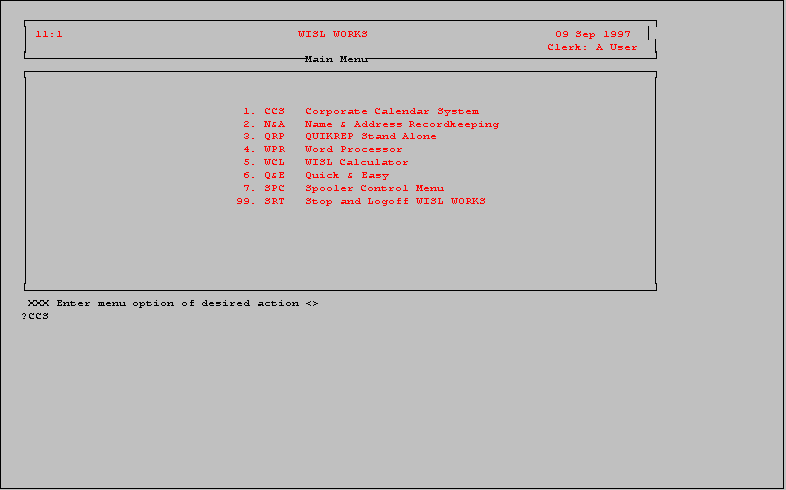
WISL WORKS
Overview
Waterloo Information Systems Limited
33 Dupont Street East
Waterloo, Ontario
N2J 2G8
© Waterloo Information Systems Limited 1995
The information contained herein is proprietary and considered a trade secret of Waterloo Information Systems Limited and shall not be reproduced in whole or in part without the written authorization of Waterloo Information Systems Limited.
I. Introduction
WISL has developed a number of facilities to support daily office activities that incorporate the multiuser and database capabilities characteristic of sophisticated institutional applications but with a user interface similar to that of the PC world. In fact some WISL WORKS applications interface directly with popular PC word processors including WordPerfect and Word and the most commonly used spreadsheets, LOTUS and EXCEL.

WISL WORKS incorporates many of the best aspects of both PC computing and institutional computing in the Open Systems computing environment. WISL WORKS addresses the needs of people for information facilities in a corporate context and may be characterized as corporate computing.
II. Corporate Computing
Corporate computing is the evolutionary result of merging the best of two divergent technologies in the computing world. Institutional computing and personal computing developed extensively during the decade of the 80's with two quite different sets of goals.
The focus for institutional computing has been on computerizing large operational functions often involving massive data bases. Clearly the priority has been data base management with the major platform being the imposing mainframe.
Personal computing on the other hand has concentrated on the user interface to computing. The personal computer evolved with the goal of making the use of computers attractive for personal use.
A great deal of effort has been expended by both camps to encroach upon the realm of the other. Inherent weaknesses in each of these computing environments prohibit them from providing an effective basis for corporate computing.
The emerging Open Systems environment with the capacity of mainframes in affordable boxes, utilizing a legitimate multiuser operating system but providing access to advanced graphical user interfaces and "open" communication facilities is an attractive platform for the support of corporate computing.
Information Systems
The greatest responsibility in computerizing information systems in organizations is to effectively organize and store the data such that it may be conveniently accessed for various purposes by many different people. This is called data base management and scores of methodologies have evolved over the years to address this issue.
As many institutional activities are interrelated it is also important that as records are updated the latest status of the record is immediately available to all users of the system.
These two requirements have spawned and nurtured the development of huge and expensive mainframe computers and their companion operating systems. As well as having a high acquisition cost these systems tend to require a great amount of internal expertise to operate. On top of these heavy costs is the unsettling fact that these systems are proprietary with little competitive support available if trouble arises with the supplier.
Personal Computing
To its credit the personal computer phenomenon has raised the general awareness of the capabilities of computers and has developed the man/machine interface. However, PC based systems have proven woefully inadequate when applied to address organizational information systems problems. An average down time of 6% for such systems is condemnation enough but they also tend to be slow for such tasks and are generally lacking in data integrity.
Although hardware has improved dramatically in terms of capacity, the greatest weakness in the PC world remains the operating system and network software. The twin requirements of institutional information systems, data base management and real time processing, cannot be adequately addressed by PC based systems.
Open Systems
Open Systems has achieved notoriety only recently but it has been growing since the early 70's. It evolved in the academic/scientific community with the predictable emphasis on calculation and communication. UNIX was the operating system from the outset. Although not truly non-proprietary, as each vendor markets its own version, the strength of UNIX is that all versions adhere to recognized standards that enable the portability of applications amongst platforms. These standards have been formalized by various government and industry regulatory groups and now constitute the definition of "Open Systems".
The development of RISC technology with the consequent multiplication of system power has made the Open Systems environment very attractive for the application of institutional information systems. All of the major commercial data base management systems have been converted to run in the Open Systems environment. Coupled with incomparable communications facilities and the advanced PC like graphical user interfaces available, the relatively inexpensive Open Systems platforms are rapidly displacing proprietary mainframes.
III. WISL WORKS Components
WISL WORKS incorporates many of the best characteristics of both institutional and personal computing in the Open Systems environment. The Corporate Calendar provides all of the features of the best available personal calendar while providing direct access to each individual's calendar by all other participants. Immediate knowledge of each participant's whereabouts and the ease in arrangement of meetings amongst participants are features well beyond the capability of PC based calendars.
The Name & Address facility provides data base management capabilities equal to those characteristic of mainframe information systems yet it seamlessly interfaces with PC based word processors for the generation of letters and other documents.
WISL WORKS provides the tools to take a giant step toward improving the operation of your office.
There are five major goals of the Corporate Calendar facility:
1. To monitor the whereabouts of the participants
2. To assist in arranging meetings amongst participants
3. To provide personal calendaring facilities to the participants
4. To provide for the recording of and access to phone messages
5. To provide for the recording and reporting of personal activities within a corporate context.
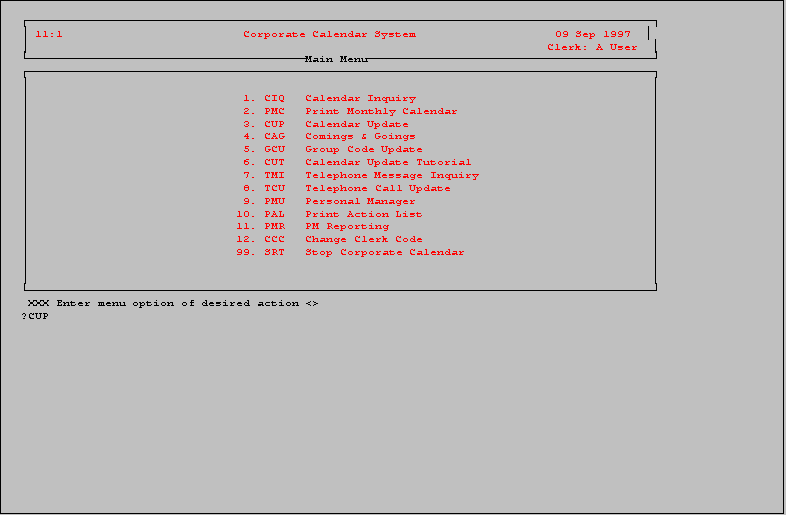
It is important that the calendars of the participants be up to date to assure the achievement of the first two goals. The system facilities have been designed to provide the flexibility of allowing update of calendar entries or comings and goings by the participants or by support staff.
The related functions of telephone messaging and personal activity management are addressed with similar interactive facilities. At any prompt in any of these routines the user may transfer into another and subsequently return with ease.
A common need in many organizations is the ability to perform record keeping activities on miscellaneous groups of people. It typically requires the recording of contact information(name, address, phone and fax) along with other miscellaneous items of data. A customized solution for each of these types of requirements could not be justified.
Name & Address is a generalized solution for these applications that provides rich data base management and reporting capabilities fully integrated with word processing.
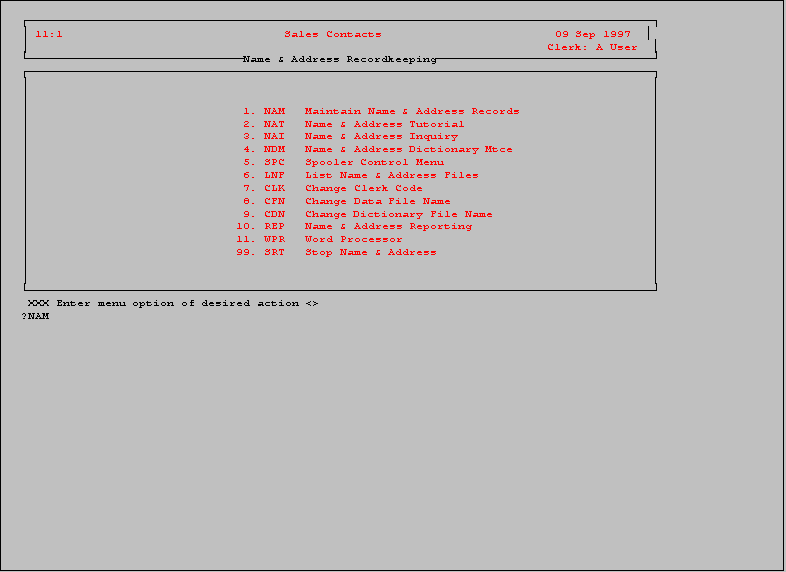
QUIKREP provides the end user with the capability to generate reports without the technical expertise of a programmer. Under interactive control the user specifies everything from the action verb to the data attributes displayed and the heading or footing that will appear on the report.
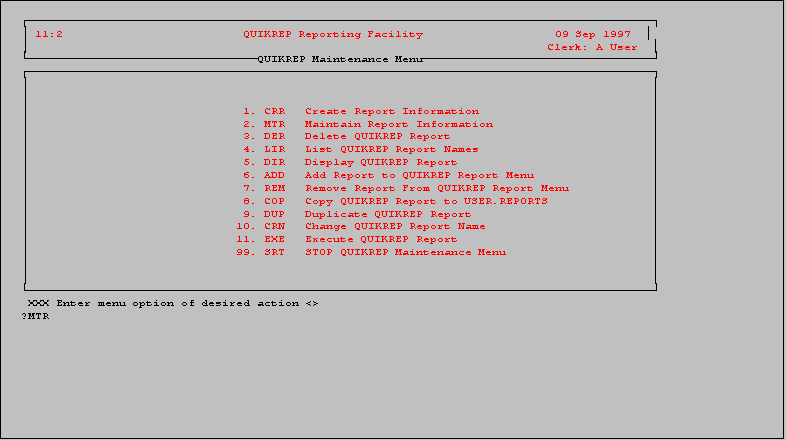
Once created the report can be stored in a menu to be executed automatically when required. It can be easily modified or copied to provide the basis for a different report.
Two important features that distinguish the WISL calculator from other system provided calculators are that it evaluates algebraic expressions and it provides reports on the transactional activity in the session both on the screen and to a specified printer.
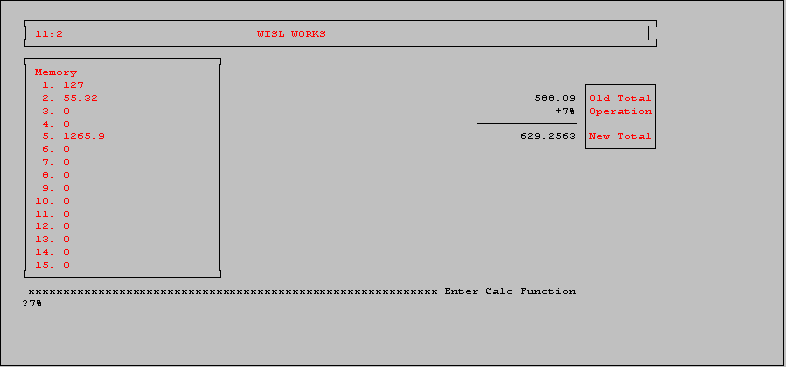
Each of the above facilities are easy to use but do require some effort to navigate the menus. It is often desired to access a portion of one of the WISL WORKS facilities(usually a report) without entering the menu structure. Q&E has been developed to provide quick and easy access to specified WISL WORKS features. The selection can be customized for each user with a default for each installation.
Often an organization will provide a variety of print devices to accommodate office needs. The spooler control menu action provides for the specification of the printer to be used for WISL WORKS functions.